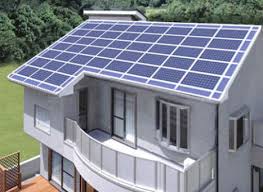Solar BIPV

Mehr Solar works directly with your residential or commercial builder, developer &/or architect to select and implement the most cost-effective BIPV technology specific to your needs & to maximize your ROI.
Building-integrated photovoltaic (BIPV) are photovoltaic materials that are used to replace conventional building materials in parts of the building envelope such as the roof, skylights, or facades. They are increasingly being incorporated into the construction of new buildings as a principal or ancillary source of electrical power, although existing buildings may be retrofitted with similar technology.
The advantage of integrated photovoltaic over more common non-integrated systems is that the initial cost can be offset by reducing the amount spent on building materials and labor that would normally be used to construct the part of the building that the BIPV modules replace. These advantages make BIPV one of the fastest-growing segments of the photovoltaic industry.
The term building-applied photovoltaic (BAPV) is sometimes used to refer to photovoltaics that are retrofit – integrated into the building after construction is complete. Most building-integrated installations are BAPV. Some manufacturers & builders differentiate new construction BIPV from BAPV.
Benefits
Following are the three main benefits of BIPV according to New York Solar Energy Society:
* Cost: adding BIPV may cost you nothing compared to conventional building material costs.
Every approach to building design should satisfy needs and cost you less in the long run. Take whatever your current conventional construction material and labor budget are for roofing, building envelope, canopies, thermal heating, and cooling. Then double it. That’s what adding BIPV will cost you in the short term. However, BIPV with its incentives and unique tax advantages costs you less than conventional building materials in the long run. Plus “A penny saved is a penny earned.”
Once in place, conventional building materials are revenue static, offering little or no savings over time. By adding BIPV versus the cost of conventional construction materials and labor, the building envelope, roof or canopy now becomes a revenue center with up to 30 years of savings from system-generated electricity.
*Efficiency: peak power consumption is offset simultaneously by peak energy production.
During the day, maximum sunlight hours and solar power system energy production generally correspond with peak electricity demand. This is even more important because peak production from the system is realized during daylight hours when utility prices are highest.
*Aesthetic: with BIPV, architectural design isn’t sacrificed for the integration of solar power systems.
Many have said, “I want to add solar, but I don’t want to see it.” So when does solar not look like solar? When it’s seamlessly blended into building architecture using BIPV. That’s the void in solar integration that BIPV fills. Architectural canopies, facades, curtain walls, roof, and skylight systems are all examples of how BIPV can be an aesthetic rather than a design compromise.
Unlike the subjective social and environmental benefits of solar power which are hard to quantify, BIPV’s economic benefits are real, easily measured, and unique to the BIPV approach of building design and architecture. No other integration of solar or wind power generation can make that claim. BIPV and building performance concepts are only limited by imaginative design concepts and innovative applications of today’s solar products. courtesy of New York Solar Energy Society


